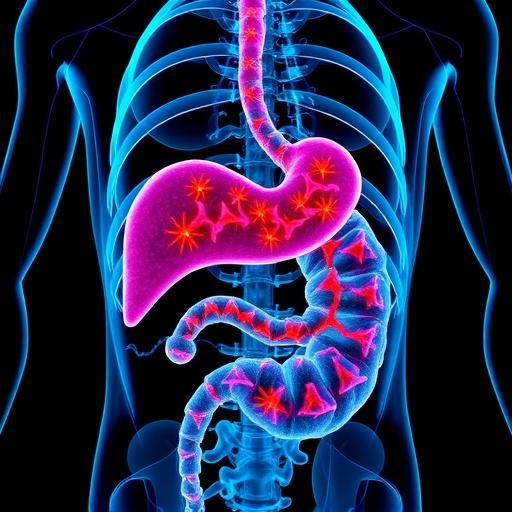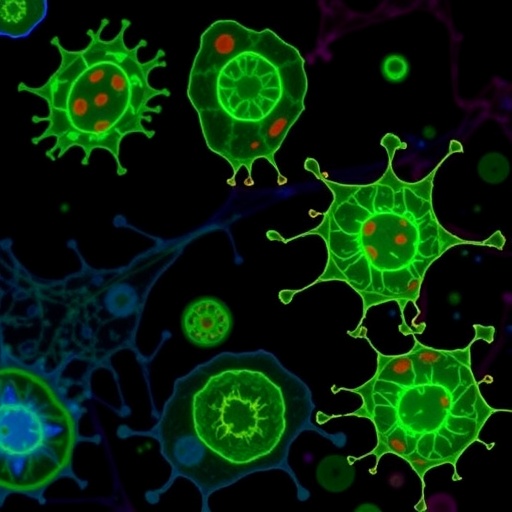In a groundbreaking advancement poised to reshape the landscape of cancer therapy, researchers at the Innovation Center of NanoMedicine (iCONM) have unveiled a revolutionary stealth coating technology that dramatically extends the circulation time of nanomedicines within the bloodstream. Published in the esteemed journal Nature Biomedical Engineering, this pioneering work shuns the conventional reliance on polyethylene glycol (PEG) coatings and instead harnesses an intricately engineered ion-pair network. This novel molecular architecture forms a robust, semipermeable “cloak” enveloping nanocarriers, effectively evading immune detection and clearance while maintaining functional permeability to therapeutic enzymes.
The core innovation lies in the creation of a stable ion-pair network, which is fabricated by mixing polycations and polyanions—charged polymeric chains—followed by controlled crosslinking. This crosslinked network serves as a stealth shield by minimizing nonspecific protein adsorption and reducing uptake by macrophages, the frontline immune cells responsible for eliminating foreign materials. Remarkably, the enhanced stability achieved through this ion-pair mechanism enables nanocarriers to persist in circulation with a half-life exceeding 100 hours, a substantial improvement over traditional PEGylation strategies. This advancement marks a pivotal shift from steric stabilization approaches, which solely prevent molecular interactions by spatial hindrance, to chemically and electrostatically stabilized nanosystems.
The clinical implications of this technology are profound, particularly in the realm of cancer therapy. Conventional nanomedicine approaches focus on maximizing drug payload delivery to tumor sites, often limited by rapid immune clearance and inefficient tumor penetration. The new stealth cloak concept introduces an entirely new therapeutic paradigm: in-body nanomachines engineered not just to deliver drugs, but to reprogram the tumor microenvironment itself. Specifically, the ion-pair coated nanoreactors are loaded with asparaginase, an enzyme that depletes L-asparagine, a critical nutrient required for cancer cell survival and proliferation. By circulating for extended durations, these nanoreactors induce systemic asparagine starvation, effectively “starving” tumor cells across various cancer types, including notoriously resilient solid tumors.
One of the most compelling demonstrations of this technology’s potential is its efficacy against pancreatic and metastatic breast cancers. Pancreatic tumors are characterized by dense stromal barriers that impede drug delivery and immune cell infiltration, rendering many treatments ineffective. The stealth nanoreactors alleviate these barriers by reducing desmoplasia, the fibrotic tissue buildup, thereby facilitating enhanced extravasation of immune checkpoint inhibitors such as anti-PD-1 antibodies. This synergy significantly boosts immunotherapy responsiveness, heralding a new avenue for tackling one of the deadliest cancers. In metastatic breast cancer, particularly aggressive triple-negative subtypes, the extended nanoreactor activity sustains nutrient deprivation, sensitizing tumors that previously exhibited low treatment responsiveness.
The shift in therapeutic focus from direct tumor targeting to ecosystem modulation represents a conceptual leap forward. By conditioning the tumor microenvironment through metabolic disruption and stromal remodeling, these ion-pair coated nanomachines function as autonomous agents within the body, actively reshaping cancer progression pathways. This strategy not only enhances treatment efficacy but also simplifies clinical translation by diminishing dependency on precise tumor targeting mechanisms, which have historically complicated drug development pipelines. The resulting systemic approach opens possibilities for treating a broad spectrum of malignancies while potentially circumventing tumor heterogeneity-associated resistance.
Beyond cancer therapy, the broader impact of this research extends to the entire field of nanomedicine. The ion-pair stealth cloak offers a versatile platform applicable to various therapeutic agents requiring prolonged circulatory lifespans and minimal immunogenicity. Its material-agnostic nature frees future drug delivery systems from the limitations inherent to PEGylation, such as immunogenicity and accelerated blood clearance upon repeated administration. This platform has the potential to catalyze advances in enzyme therapies, diagnostic nanodevices, and targeted delivery vehicles, enabling more precise and durable interventions with reduced side effects.
The development also highlights an instrumental leap in biomaterials science. By precisely controlling intermolecular electrostatic interactions and polymer crosslinking density, researchers have engineered a nano-scale microenvironment replicating key biological stealth features. This molecular-level design integrates semi-permeability to allow substrate and product exchange with the external environment while maintaining a barrier against immune recognition. Such fine-tuned nanoscale engineering paves the way for creating sophisticated nanomachines capable of complex in vivo functionalities beyond drug delivery, including bio-sensing and localized biochemical modulation.
Technically, the fabrication method involves blending block copolymers endowed with positive and negative charges and inducing controlled crosslinking reactions to form the ion-pair network sheath. This is a departure from conventional PEGylation, which attaches inert, non-ionic polymer chains to the nanocarrier surface primarily by covalent bonds for steric shielding. The ion-pair network’s electrostatic foundation allows dynamic but stable interactions, rendering the surface robust against protein corona formation—a primary trigger of immune clearance. Evaluation in animal models confirmed that nanomachines cloaked with this network avoided rapid sequestration by the mononuclear phagocyte system, achieving circulation times previously unattainable.
Experimental validations extended beyond pharmacokinetic profiling. Functional assays demonstrated that asparaginase retained activity within the ion-pair coated nanoreactors, effectively metabolizing extracellular asparagine in vivo. Tumor tissue analyses in pancreatic cancer models revealed marked reductions in extracellular matrix components and cancer-associated fibroblast activation, correlating with improved therapeutic antibody penetration. These data suggest that multi-modal mechanisms underpin the observed therapeutic enhancements: metabolic starvation synergizes with modulated tumor stroma to enhance immunomodulatory treatments.
The research received support from Japan’s Ministry of Education, Culture, Sports, Science and Technology (MEXT) and the Japan Science and Technology Agency (JST) under the COI-NEXT program, underscoring the strategic national importance of advancing nanomedicine technologies. Intellectual property protection is underway, with patent applications already filed by key investigators. As this stealth cloak technology advances toward clinical translation, it promises to bridge the gap between laboratory innovation and transformative patient outcomes, especially for cancers historically resistant to conventional interventions.
Looking forward, the ion-pair network stealth cloak is positioned to revolutionize how nanomedicines are designed, applied, and integrated into multimodal cancer treatment regimens. Its ability to provide long-lasting, biocompatible shielding without relying on traditional steric barriers circumvents current challenges related to immune system activation and therapeutic degradation. Moreover, by facilitating enzyme-mediated metabolic interventions in the bloodstream, this approach lays critical groundwork for novel therapies not only in oncology but also in chronic metabolic disorders and infectious diseases.
With survival rates for solid tumors like pancreatic and metastatic breast cancer stubbornly low due to poor drug delivery and immunosuppressive environments, innovations like this stealth nanoreactor offer a beacon of hope. By transforming nanomedicines into active participants that manipulate biological ecosystems, researchers are charting a new course where the boundaries between therapeutic agents and biological machinery blur. This convergence of materials science, enzymology, and immunoengineering signals a paradigm shift in healthcare, where invisible nanoscale allies wage metabolic warfare on diseases from within.
Subject of Research: Animals
Article Title: Steric stabilization-independent stealth cloak enables nanoreactors-mediated starvation therapy against refractory cancer
News Publication Date: 31-Oct-2025
Web References: DOI link: 10.1038/s41551-025-01534-1
Image Credits: Kyushu University and Innovation Center of NanoMedicine (iCONM)
Keywords: nanomedicine, stealth cloak, ion-pair network, starvation therapy, asparaginase, metabolic therapy, PEG-free nanocarriers, immune evasion, pancreatic cancer, breast cancer, tumor microenvironment, enzyme-loaded nanoreactors, cancer immunotherapy
Tags: advanced nanomedicine innovationscancer treatment breakthroughscrosslinked polymeric networksenhanced nanocarrier circulation timeimmune evasion in cancer therapyion-pair network for drug deliverylong-term starvation therapyovercoming drug resistance in cancer therapyPEG alternatives in drug deliveryresistant pancreatic cancer treatmentstealth coating technology in nanomedicinetherapeutic enzyme delivery systems





